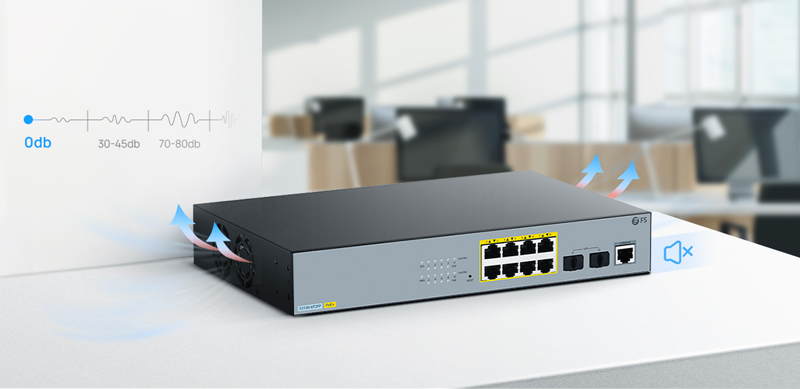How Do I Set Up a Small Business Network?
In today's digitally connected world, a well-structured small business network is the backbone of efficient operations. Whether you're running a startup or a well-established small business, a reliable network is crucial for seamless communication, data sharing, and accessing online resources. This article will guide you through the process of setting up a small business network, highlighting essential equipment and offering tips for success.
Essential Equipment
Before diving into the setup process, it's essential to understand the core components of a small business network. These components include a small business switch and a small business router.
Small Business Switch
A small business switch is a fundamental piece of networking equipment that allows devices within your network to communicate with one another. Unlike basic consumer-grade switches, a small business switch offers more advanced features and better scalability.
When choosing a switch, consider factors such as the number of ports, data transfer speeds (usually measured in gigabits per second or Gbps), and management capabilities. Managed switches provide greater control over your network and can prioritize certain types of traffic, making them a good choice for businesses with more complex networking needs.

Small Business Router
A small business router serves as the gateway between your local network and the internet. It provides security features like firewalls, VPN support, and NAT (Network Address Translation), which help protect your network from external threats.
When selecting a router, consider your internet connection type (DSL, cable, fiber, etc.), the number of users, and the features you need. Some routers also include built-in wireless capabilities (Wi-Fi), making them an all-in-one solution if your business requires wireless connectivity.
Tips for Success
Now that you understand the essential equipment, let's explore some key tips for setting up a successful small business network.
Choose the Right Network Design
The first step in creating an efficient small business network is designing it properly. Consider your business's unique needs and layout when planning your network. Here are a few design aspects to keep in mind:
-
Segmentation: Divide your network into logical segments to enhance security and performance. For instance, you might create separate segments for employees, guests, and IoT devices.
-
Redundancy: Plan for redundancy in critical areas of your network to minimize downtime in case of hardware failures. Redundant switches, routers, and internet connections can keep your business running smoothly.
-
Scalability: Anticipate growth and choose a network design that can easily accommodate new devices and users. This might involve investing in switches and routers with additional ports or capabilities.
Prioritize Security
Security should be a top priority when setting up your small business network. Protecting your data, customer information, and sensitive business operations is essential. Here's how you can enhance network security:
-
Firewalls: Use the firewall features on your router and consider deploying additional firewall appliances to protect your network from external threats.
-
Virtual Private Network (VPN): Implement a VPN for secure remote access to your network. This is crucial if your employees need to work remotely or access network resources from outside the office.
-
Regular Updates: Keep your network equipment's firmware and software up to date to patch security vulnerabilities.
-
Strong Passwords: Enforce strong password policies for all network users, and consider implementing two-factor authentication for added security.
Quality Networking Equipment
Investing in high-quality networking equipment can save you time, money, and frustration in the long run. Cheap, unreliable equipment can lead to network issues and downtime. Look for reputable brands and products that offer good customer support and warranty coverage.
Regular Backups
Data loss can be catastrophic for a small business. Implement a robust data backup and recovery plan. Regularly back up critical data and test your backup system to ensure it can restore data effectively in case of an emergency.
Monitoring and Maintenance
Once your network is up and running, don't neglect regular monitoring and maintenance. This includes:
-
Network Monitoring: Use network monitoring tools to keep an eye on network performance, spot issues early, and address them proactively.
-
Software Updates: Regularly update the software and firmware on your network equipment to ensure it remains secure and performs optimally.
-
User Training: Educate your employees about best practices for using the network safely and securely, including recognizing and avoiding potential threats like phishing emails.
Scalability
Plan for the future by ensuring your network is scalable. As your business grows, you may need to add more devices, users, or network segments. Choose equipment and network architecture that can accommodate expansion without major disruptions.
Summary
In conclusion, a well-structured small business network is crucial for efficient operations and competitiveness in today's business landscape. To set up a successful network, invest in essential equipment like a small business switch and router, and follow the tips outlined in this article:
-
Choose the right network design tailored to your business needs.
-
Prioritize network security with firewalls, VPNs, and regular updates.
-
Invest in high-quality networking equipment to ensure reliability.
-
Implement regular backups and disaster recovery plans.
-
Monitor and maintain your network to prevent issues and downtime.
-
Plan for scalability to accommodate future growth.
By following these guidelines and continuously improving your network infrastructure, you can create a robust and reliable small business network that supports your business's goals and objectives.
You might be interested in
Email Address

-
PoE vs PoE+ vs PoE++ Switch: How to Choose?
May 30, 2024














